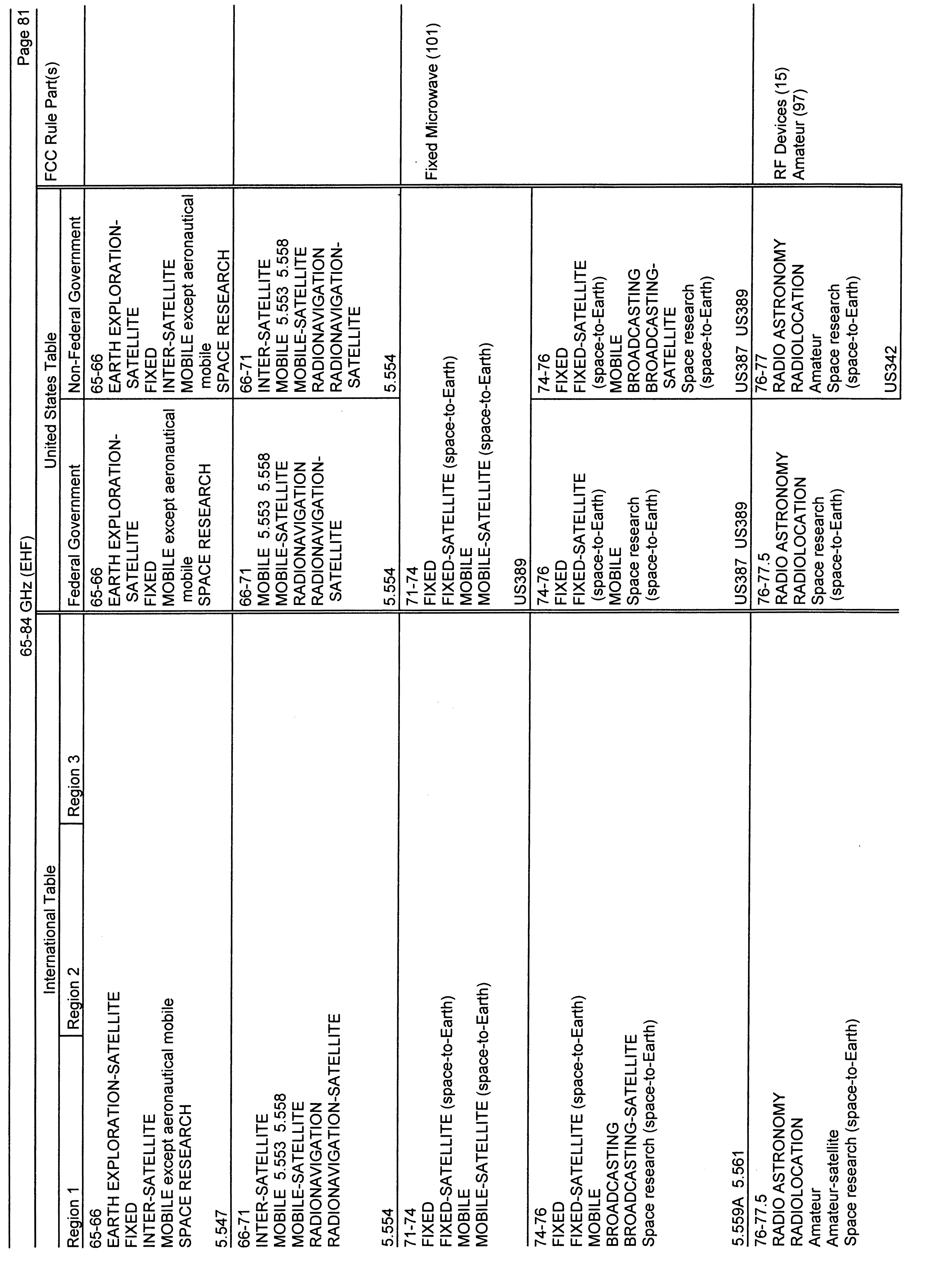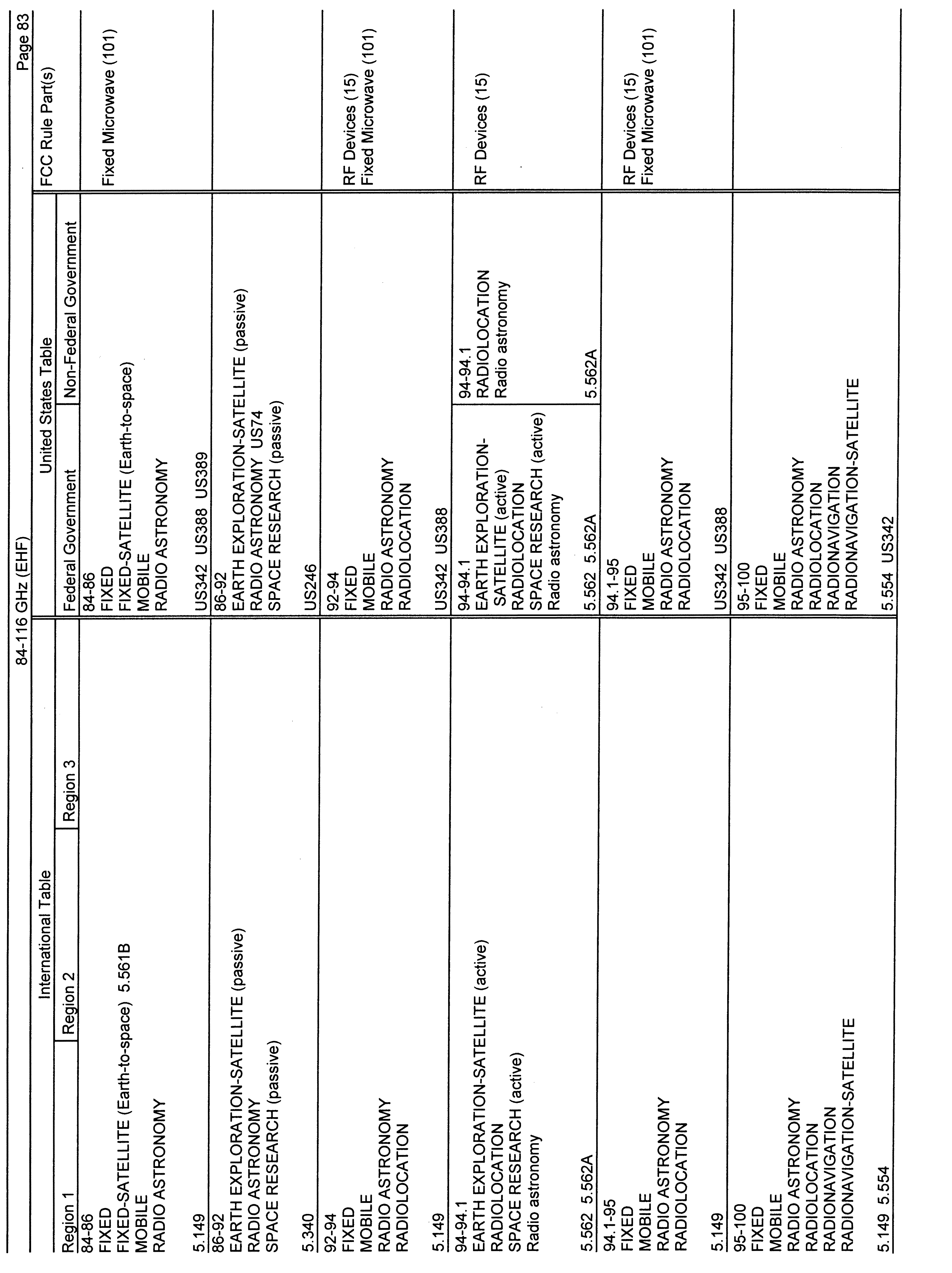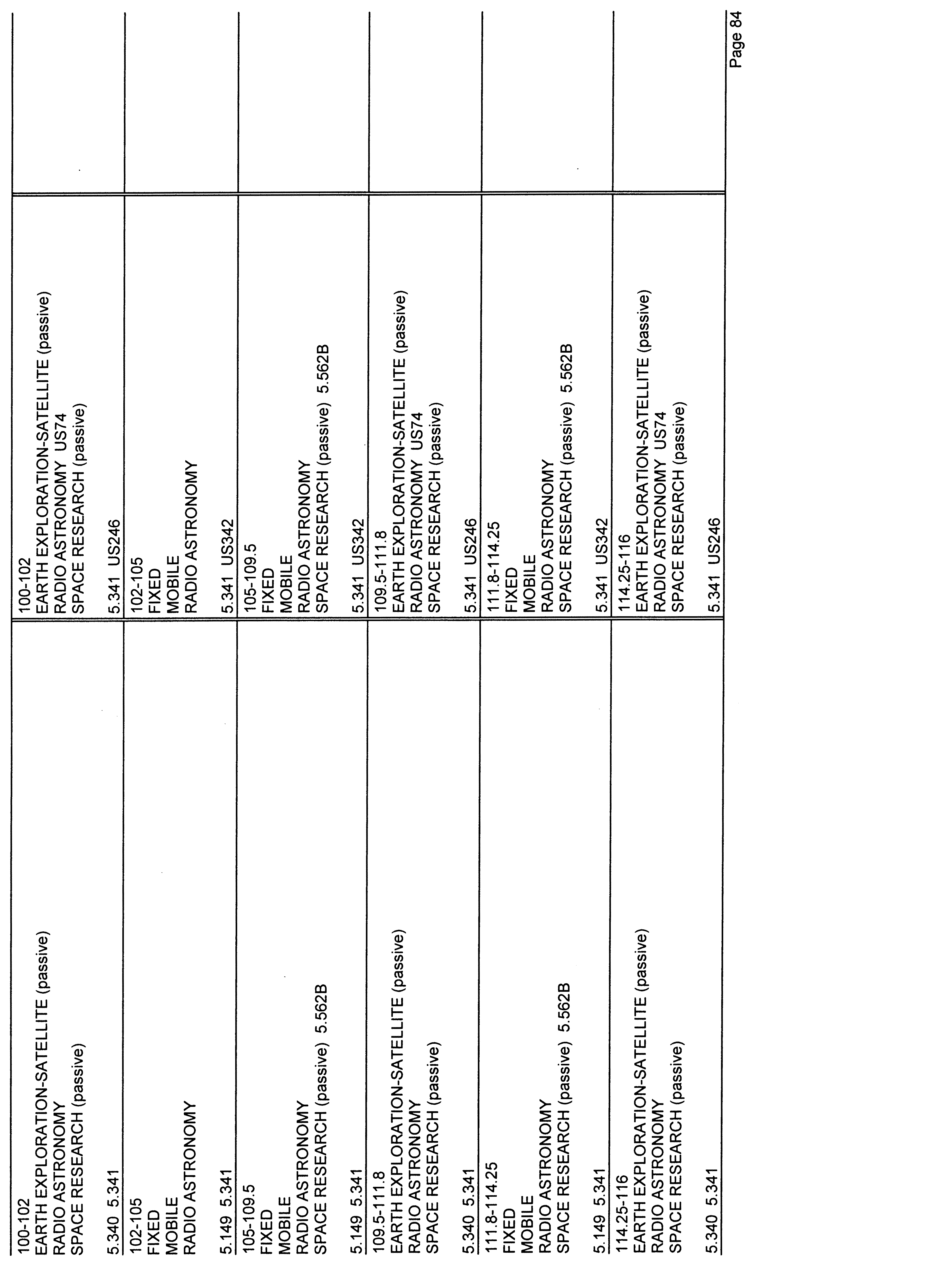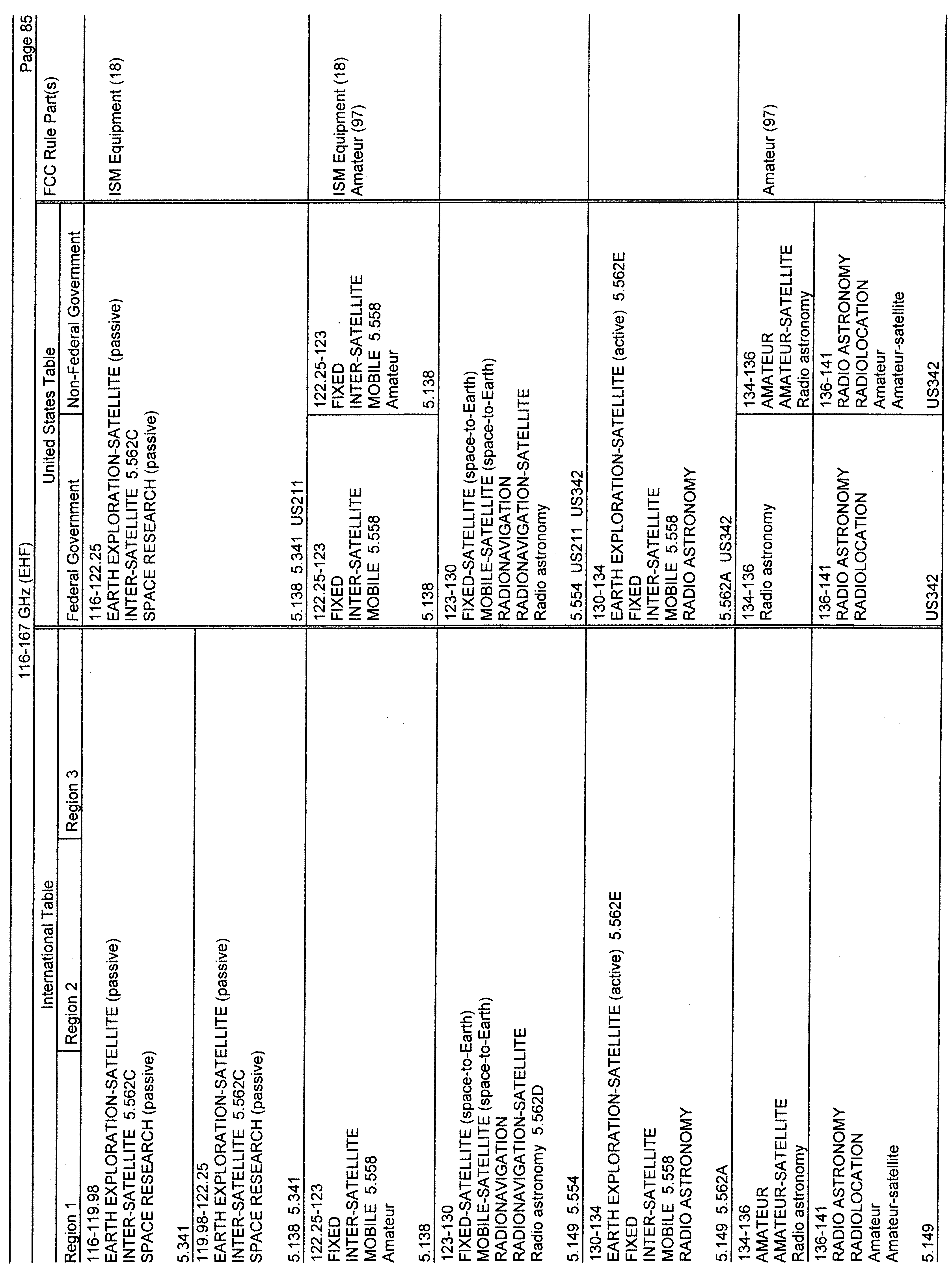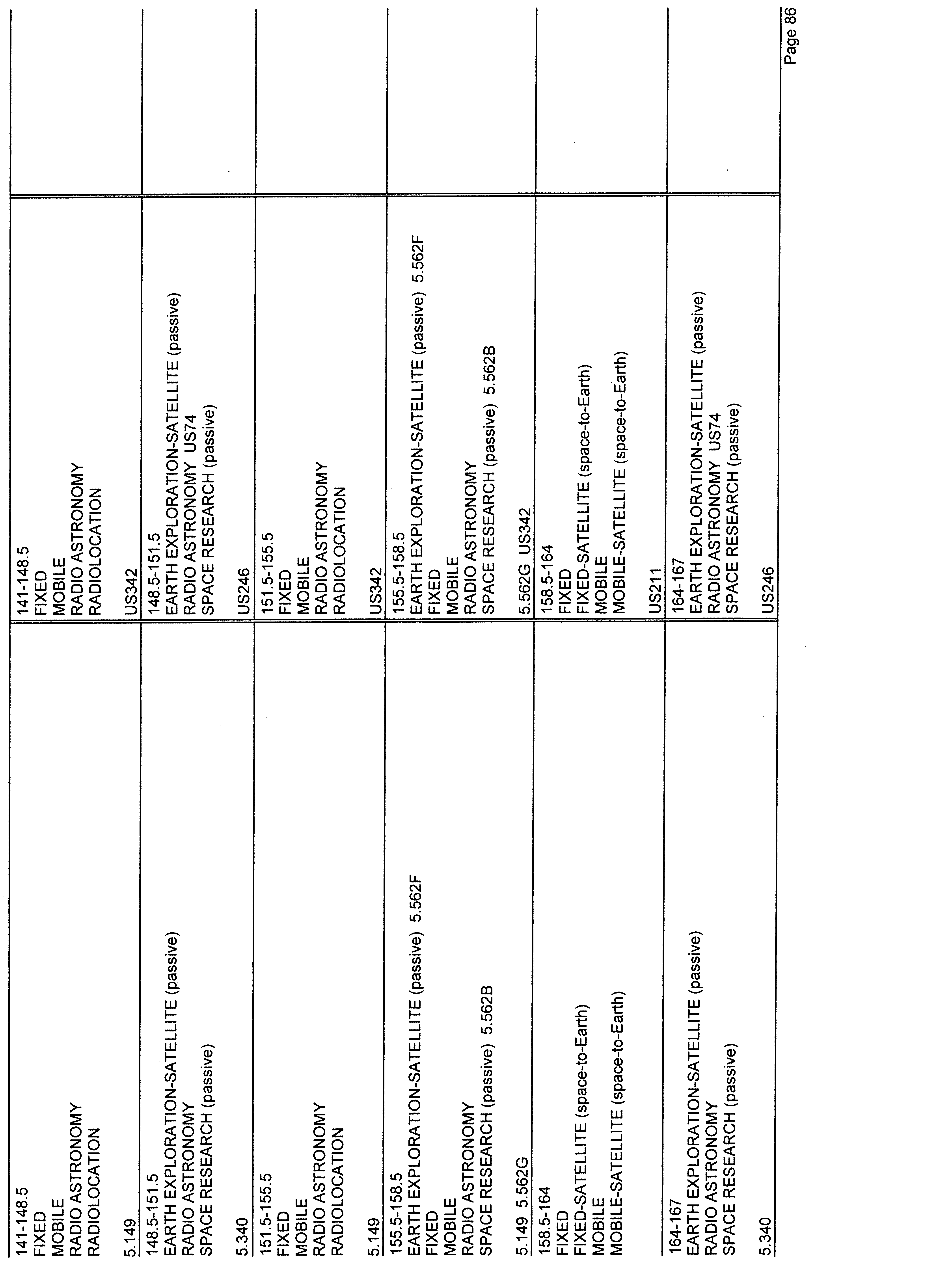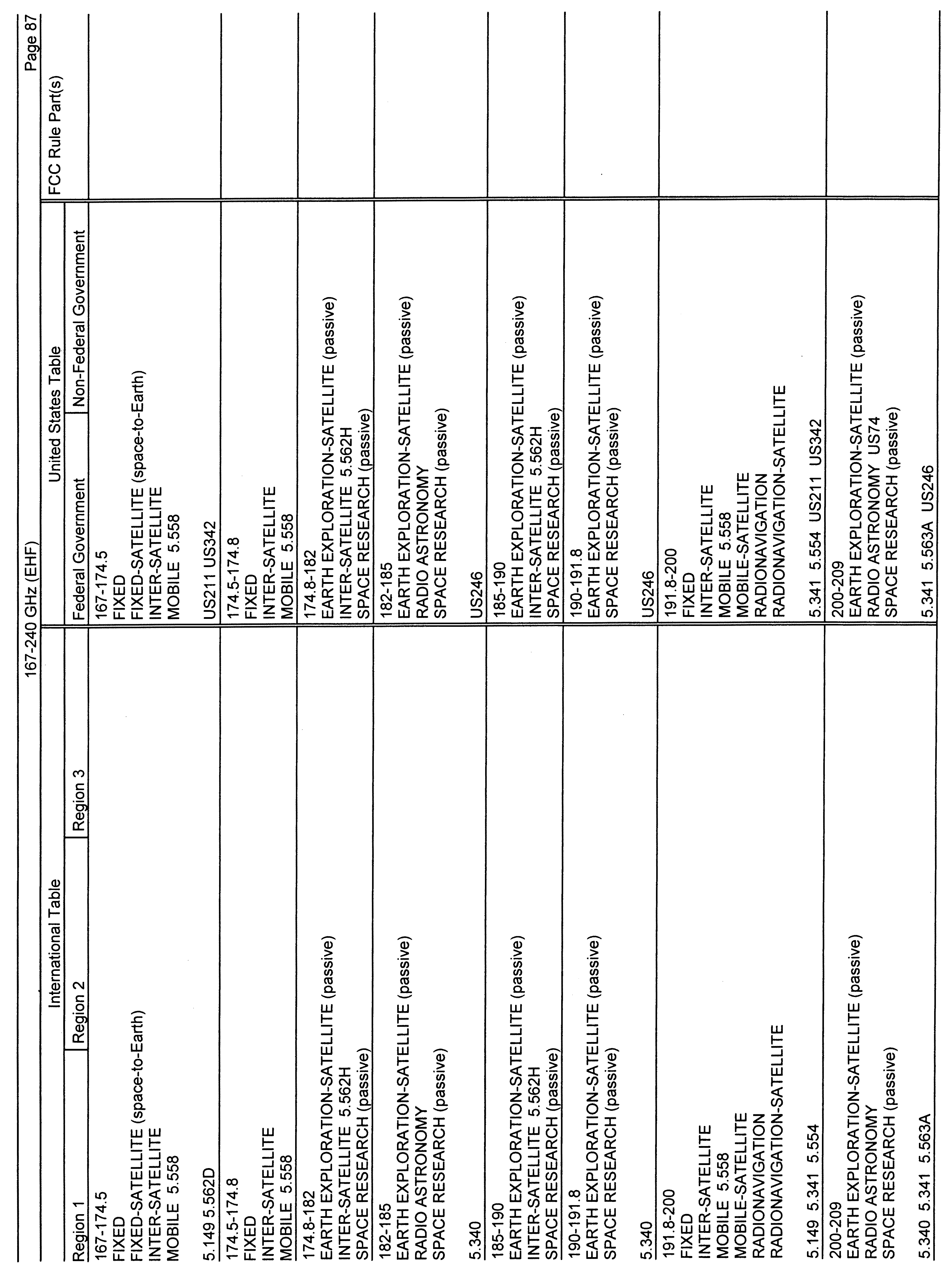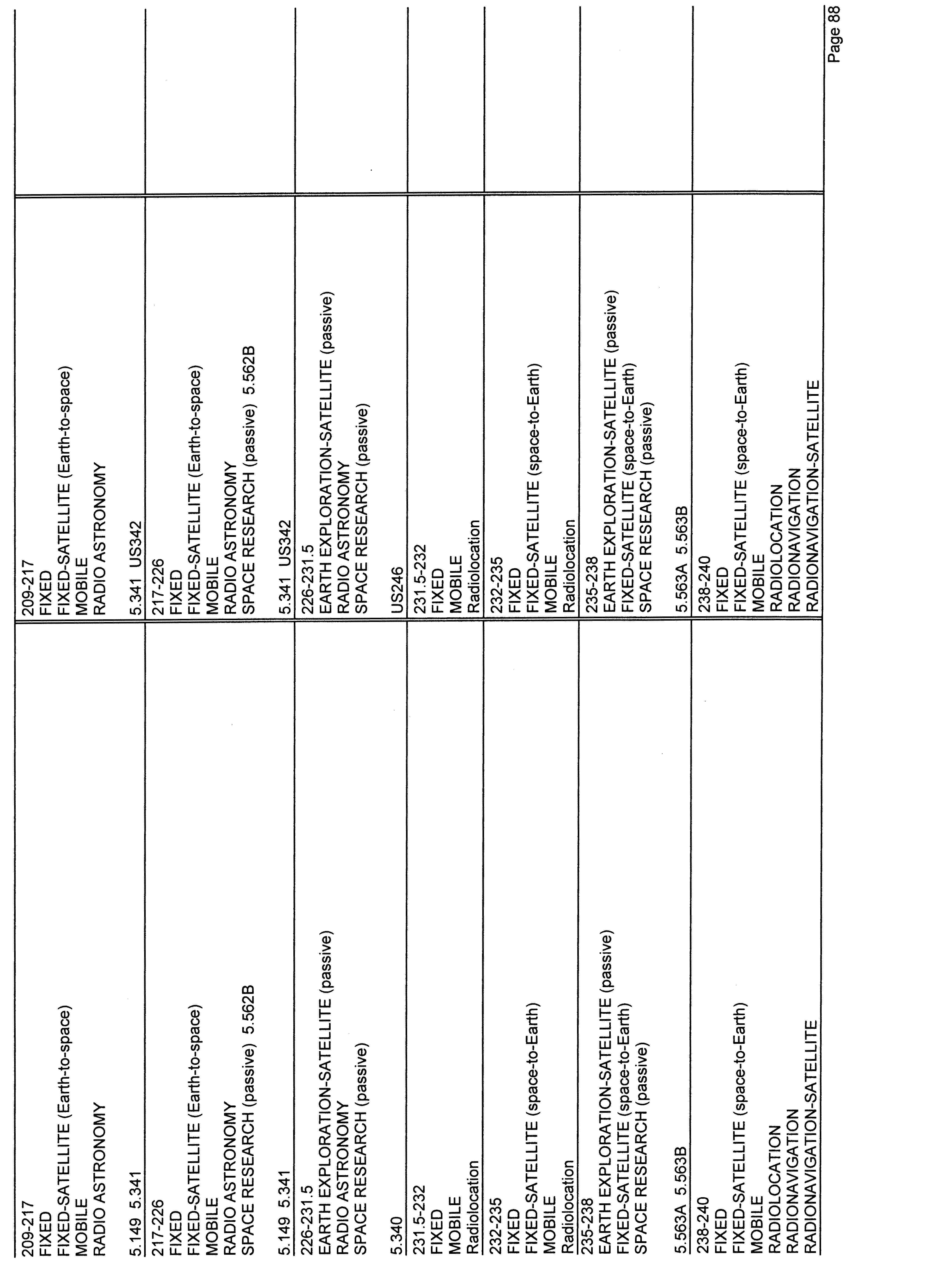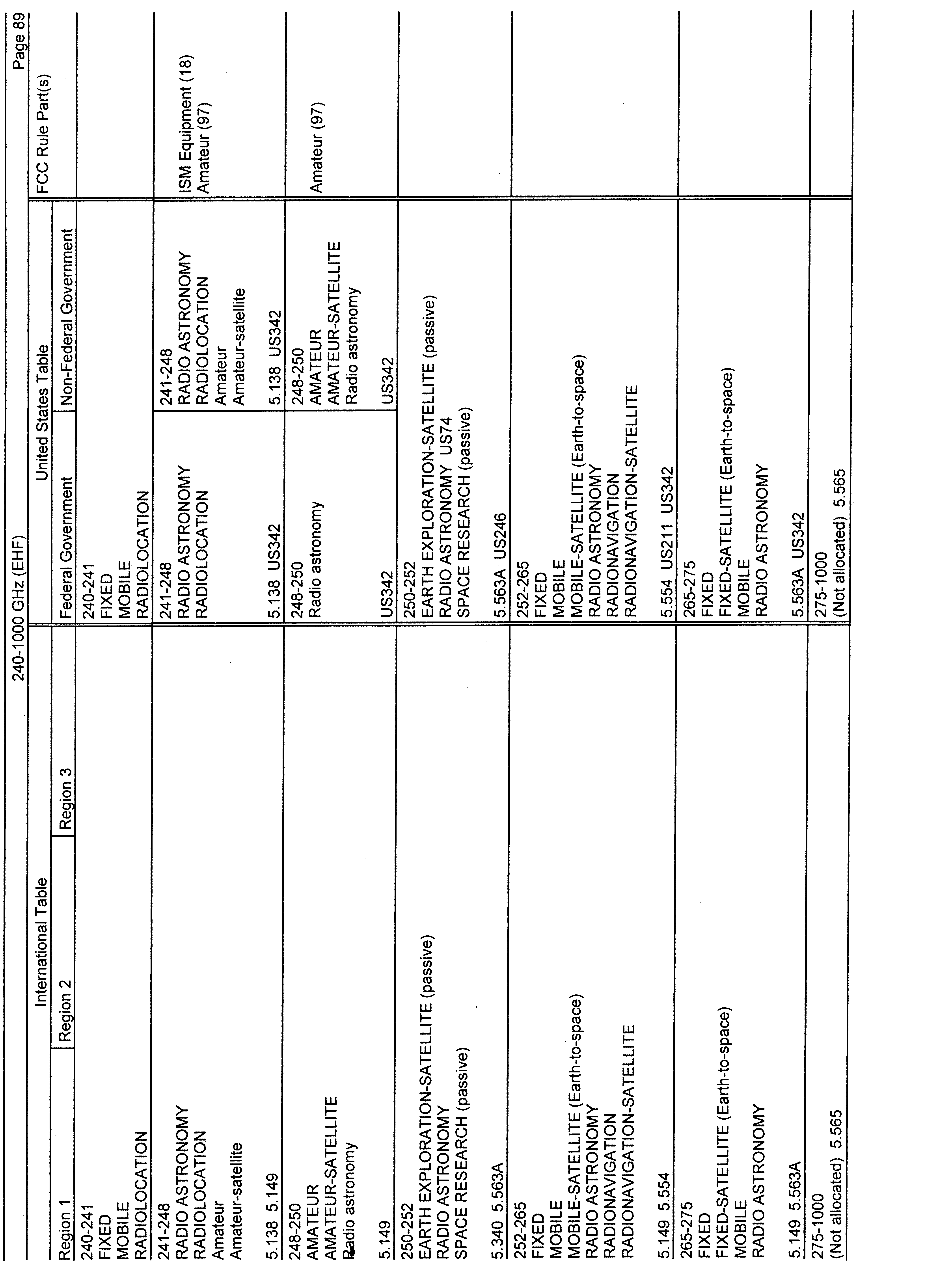-
Start Preamble
AGENCY:
Federal Communications Commission.
ACTION:
Final rule.
SUMMARY:
In this document, the Commission reallocated spectrum in the 76-81 GHz frequency band and the frequency bands above 95 GHz to conform the United States Table of Frequency Allocations with recent changes to the International Table of Frequency Allocations maintained by the International Telcommunication Union. In order to protect passive services in the 55.78-56.26 GHz band, the Commission also adopted a limit on the maximum power spectral density that can be delivered to a fixed service transmitter antenna.
DATES:
Effective April 23, 2004.
Start Further InfoFOR FURTHER INFORMATION CONTACT:
Shameeka Hunt, Office of Engineering and Technology, (202) 418-2062, email: Shameeka.Hunt@fcc.gov
End Further Info End Preamble Start Supplemental InformationSUPPLEMENTARY INFORMATION:
This is a summary of the Commission's Report and Order, ET Docket No. 03-102, FCC 04-20, adopted February 4, 2004, and released February 12, 2004. The full text of this Commission decision is available on the Commission's Internet site at www.fcc.gov. It is available for inspection and copying during normal business hours in the FCC Reference Information Center, Room CY-A257, 445 12th Street, SW., Washington, DC 20554. The complete text of this document also may be purchased from the Commission's copy contractor, Qualex International, Room CY-B402, 445 12th Street, SW., Washington, DC 20554. Alternate formats are available to persons with disabilities by contacting Brian Millin at (202) 418-7426 or TTY (202) 418-7365.
Summary of the Report and Order
1. In the Report and Order, the Commission amended part 2 of the Commission's rules to realign spectrum in the 76-81 GHz frequency band and the frequency bands above 95 GHz to conform the United States Table with international allocation changes made at WRC-2000. The Commission also set a maximum power spectral density limit in the 55.78-56.26 GHz band to protect passive services.
2. Above 76 GHz. The Commission found that implementing the allocation changes from WRC-2000 in these bands was necessary to provide EESS and RAS operations with the flexibility to operate in spectrum suited to meet their needs. This action also promoted consistency between the U.S. Table and the International Table.
3. Regarding the 76-77 GHz band, the Commission recognized that vehicular radar operations in this band may be able to increase the level of safety on highways and benefit the public. The Commission agreed with commenters that sharing between RAS and SRS and vehicular radar operations was possible. Therefore, the 76-77 GHz band was allocated to the RAS on a primary basis and to the SRS on a secondary basis, as proposed.
4. In addition, the Commission found evidence of potential interference conflicts between the amateur-satellite service and vehicular radar systems. On this basis, it was anticipated that an amateur earth station could either receive interference to its operations or cause interference to a passing vehicular radar device. Therefore, the proposed secondary amateur-satellite allocation for the 76-77 GHz band as not implemented. However, the existing secondary amateur service allocation was retained, noting that the existing secondary amateur service allocation in this band was currently suspended and restricted until technical sharing criteria was developed to address potential sharing problems in this band. The Commission also found that not allowing amateur operations in the 76-77 GHz band was not a significant burden on this service because amateurs typically do not operate at these higher frequencies and they are permitted to operate in the adjacent 77-81 GHz band.
5. Regarding the 77-81 GHz segment, the Commission adopted domestically the RAS and SRS allocations as proposed in the Notice of Proposed Rule Making (NPRM), 68 FR 33043, June 3, 2003. Also, the Commission adopted the proposal set forth in the NPRM to realign spectrum in the bands above 95 GHz. This realignment would have little impact on the small number of systems that are currently implemented in these bands and no parties filed comments opposing these changes. It was found that potential interference conflicts between allocations or development of technical sharing criteria would be addressed, as appropriate, as future applications are developed or through the development of service rules.
6. Finally, the Commission deleted the seven United States footnotes that were adopted in the Table Clean-up Order in DA No. 02-1872, 67 FR 59601, September 23, 2002, for the purpose of maintaining the status quo for the U.S. Table, since the Report and Order adopted the realignment of WRC-2000, these footnotes no longer applied.
7. Maximum Power Density in the Band 55.78-56.26 GHz. The Commission found that the current state of the art output power for fixed systems operating in this spectrum was still several dB less than the power that Start Printed Page 13747would be permitted under the output power limit of −28.5 dB(W/MHz) that was recommended. It was noted that no licenses had been issued for operation in the fixed service in the 55.78-56.26 GHz band and that the Commission had only granted a few experimental licenses in this spectrum. Therefore, to protect EESS from unaccepted interference from fixed and mobile operations, footnote US379 was adopted, which limited the maximum power density delivered to fixed service transmitter antennas to −28.5 dB(W/MHz)
Final Regulatory Flexibility Analysis
8. As required by the Regulatory Flexibility Act (“RFA”),[1] the Commission incorporated an Initial Regulatory Flexibility Analysis (“IRFA”) in the Notice of Proposed Rulemaking and Order (“NPRM”), ET Docket No. 03-102.[2] The Commission sought written public comments on the proposals in the NPRM, including the IRFA. The Final Regulatory Flexibility Analysis (“FRFA”) in the Report and Order conforms to the RFA, as amended by the Contract With America Advancement Act of 1996 (“CWAAA”), Public Law 104-121, 110 Stat. 847 (1996).
9. The RFA directs agencies to provide a description of, and, where feasible, an estimate of the number of small entities that may be affected by the action taken.[3] The RFA generally defines the term “small entity” as having the same meaning as the terms “small business,” “small organization,” and “small governmental jurisdiction.”[4] In addition, the term “small business” has the same meaning as the term “small business concern” under the Small Business Act.[5] A small business concern is one that: (1) Is independently owned and operated; (2) is not dominant in its field of operation; and (3) meets any additional criteria established by the Small Business Administration (“SBA”).[6] A small organization is generally “any not-for-profit enterprise which is independently owned and operated and is not dominant in its field.”[7] Nationwide, as of 1992, there were approximately 275,801 small organizations.[8] Finally, “small governmental jurisdiction” generally means “governments of cities, counties, towns, townships, villages, school districts, or special districts, with a population of less than 50,000.”[9]
10. The Commission will send a copy of this Final Regulatory Flexibility Analysis, along with this Report and Order, in a report to be sent to Congress pursuant to the Congressional Review Act, 5 U.S.C. 801(a)(1)(A). In addition, the Commission will send a copy of this Report and Order, including this FRFA, to the Chief Counsel for Advocacy of the Small Business Administration.
Start List of SubjectsList of Subjects in 47 CFR Part 2
- Radio
End SignatureFederal Communications Commission.
Marlene H. Dortch,
Secretary.
Rule Changes
Start Amendment PartFor the reasons discussed in the preamble, the Federal Communications Commission amends 47 CFR part 2 as follows:
End Amendment Part Start PartPART 2—FREQUENCY ALLOCATIONS AND RADIO TREATY MATTERS; GENERAL RULES AND REGULATIONS
End Part Start Amendment Part1. The authority citation for part 2 continues to read as follows:
End Amendment Part Start Amendment Part2. Section 2.106, the Table of Frequency Allocations, is amended as follows:
End Amendment Part Start Amendment Parta. Revise pages 79 and 81 through 89 and remove page 90.
End Amendment Part Start Amendment Partb. In the list of International Footnotes, remove footnotes 5.563 and 917; remove headings “I: New Numbering Scheme” and “II: Old Numbering Scheme”; and remove Note immediately following the heading “INTERNATIONAL FOOTNOTES.”
End Amendment Part Start Amendment Partc. In the list of United States (US) Footnotes, revise footnotes US74, US211, US246, US263, and US342; remove footnotes US369, US371, US372, US373, US374, US375, and US376; and add footnote US379.
End Amendment PartThe revisions and addition read as follows:
End Supplemental InformationTable of Frequency Allocations.Start Printed Page 13748 Start Printed Page 13749 Start Printed Page 13750 Start Printed Page 13751 Start Printed Page 13752 Start Printed Page 13753 Start Printed Page 13754 Start Printed Page 13755 Start Printed Page 13756 Start Printed Page 13757* * * * *United States (US) Footnotes
* * * * *US74 In the bands 25.55-25.67, 73.0-74.6, 406.1-410.0, 608-614, 1400-1427, 1660.5-1670.0, 2690-2700, and 4990-5000 MHz, and in the bands 10.68-10.7, 15.35-15.4, 23.6-24.0, 31.3-31.5, 86-92, 100-102, 109.5-111.8, 114.25-116, 148.5-151.5, 164-167, 200-209, and 250-252 GHz, the radio astronomy service shall be protected from extraband radiation only to the extent that such radiation exceeds the level which would be present if the offending station were operating in compliance with the technical standards or criteria applicable to the service in which it operates. Radio astronomy observations in these bands are performed at the locations listed in US311.
* * * * *US211 In the bands 1670-1690, 5000-5250 MHz and 10.7-11.7, 15.1365-15.35, 15.4-15.7, 22.5-22.55, 24-24.05, 31.0-31.3, 31.8-32.0, 40.5-42.5, 116-122.25, 123-130, 158.5-164, 167-168, 191.8-200, and 252-265 GHz, applicants for airborne or space station assignments are urged to take all practicable steps to protect radio astronomy observations in the adjacent bands from harmful interference; however, US74 applies.
* * * * *US246 No station shall be authorized to transmit in the following bands: 73-74.6 MHz, 608-614 MHz, except for medical telemetry equipment,[1] 1400-1427 MHz, 1660.5-1668.4 MHz, 2690-2700 MHz, 4990-5000 MHz, 10.68-10.7 GHz, 15.35-15.4 GHz, 23.6-24 GHz, 31.3-31.8 GHz, 50.2-50.4 GHz, 52.6-54.25 GHz, 86-92 GHz, 100-102 GHz, 109.5-111.8 GHz, 114.25-116 GHz, 148.5-151.5 GHz, 164-167 GHz, 182-185 GHz, 190-191.8 GHz, 200-209 GHz, 226-231.5 GHz, 250-252 GHz.
* * * * *US263 In the bands 21.2-21.4 GHz, 22.21-22.5 GHz, 36-37 GHz, and 56.26-58.2 GHz, the space research and Earth exploration-satellite services shall not receive protection from the fixed and mobile services operating in accordance with the Table of Frequency Allocations.
* * * * *US342 In making assignments to stations of other services to which the bands:
13360-13410 kHz 14.47-14.5 GHz 25550-25670 kHz 22.01-22.21 GHz 37.5-38.25 MHz 22.21-22.5 GHz 322-328.6 MHz 22.81-22.86 GHz 1330-1400 MHz 23.07-23.12 GHz 1610.6-1613.8 MHz 31.2-31.3 GHz 1660-1660.5 MHz 36.43-36.5 GHz 1668.4-1670 MHz 42.5-43.5 GHz 3260-3267 MHz 48.94-49.04 GHz 3332-3339 MHz 76-86 GHz 3345.8-3352.5 MHz 92-94 GHz 4825-4835 MHz 94.1-100 GHz 4950-4990 MHz 102-109.5 GHz 6650-6675.2 MHz 111.8-114.25 GHz are allocated, all practicable steps shall be taken to protect the radio astronomy service from harmful interference. Emissions from spaceborne or airborne stations can be particularly serious sources of interference to the radio astronomy service (see Nos. 4.5 and 4.6 and Article 29 of the ITU Radio Regulations).
* * * * *US379 In the band 55.78-56.26 GHz, in order to protect stations in the Earth exploration-satellite service (passive), the maximum power density delivered by a transmitter to the antenna of a fixed service station is limited to−28.5 dB(W/MHz).
Footnotes
1. See5 U.S.C. 603. The RFA, see 5 U.S.C. 601 et seq., has been amended by the Contract With America Advancement Act of 1996, Public Law 104-121, 110 Stat. 847 (1996) (CWAAA). Title II of the CWAAA is the Small Business Regulatory Enforcement Fairness Act of 1996 (SBREFA).
Back to Citation2. See Notice of Proposed Rule Making and Order, 18 FCC Rcd 8347 (2003).
Back to Citation4. Id. 601(6).
Back to Citation5. 5 U.S.C. 601(3) (incorporating by reference the definition of “small business concern” in 15 U.S.C. 632). Pursuant to the RFA, the statutory definition of a small business applies “unless an agency, after consultation with the Office of Advocacy of the Small Business Administration and after opportunity for public comment, establishes one or more definitions of such term which are appropriate to the activities of the agency and publishes such definition(s) in the Federal Register.” 5 U.S.C. 601(3).
Back to Citation6. Small Business Act, 15 U.S.C. 632.
Back to Citation8. 1992 Economic Census, U.S. Bureau of the Census, Table 6 (special tabulation of data under contract to Office of Advocacy of the U.S. Small Business Administration).
Back to Citation1. Medical telemetry equipment shall not cause harmful interference to radio astronomy operations in the band 608-614 MHz and shall be coordinated under the requirements found in 47 CFR 95.1119.
Back to CitationBILLING CODE 6712-01-U
BILLING CODE 6712-01-CStart Printed Page 13758
[FR Doc. 04-6206 Filed 3-23-04; 8:45 am]
BILLING CODE 6712-01-U
Document Information
- Effective Date:
- 4/23/2004
- Published:
- 03/24/2004
- Department:
- Federal Communications Commission
- Entry Type:
- Rule
- Action:
- Final rule.
- Document Number:
- 04-6206
- Dates:
- Effective April 23, 2004.
- Pages:
- 13746-13758 (13 pages)
- Docket Numbers:
- ET Docket No. 03-102, FCC 04-20
- Topics:
- Radio
- PDF File:
- 04-6206.pdf
- CFR: (1)
- 47 CFR 2.106

